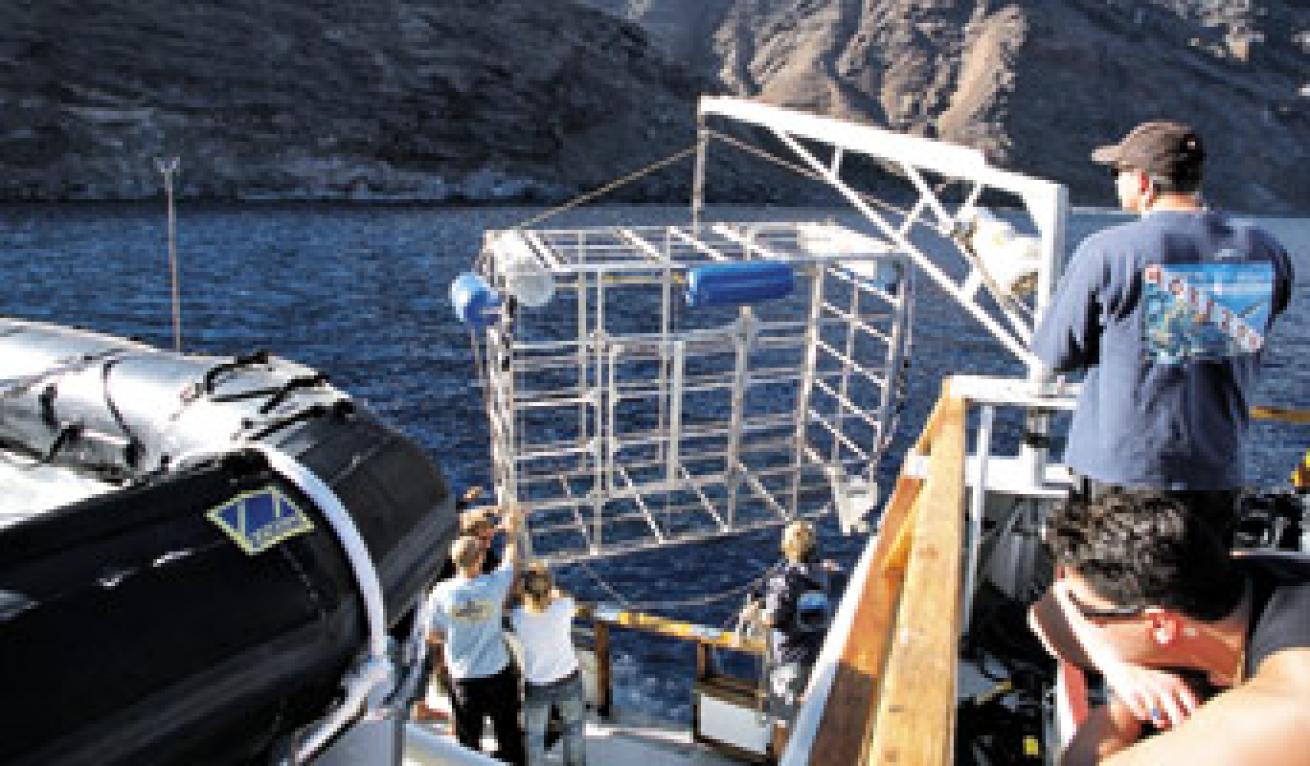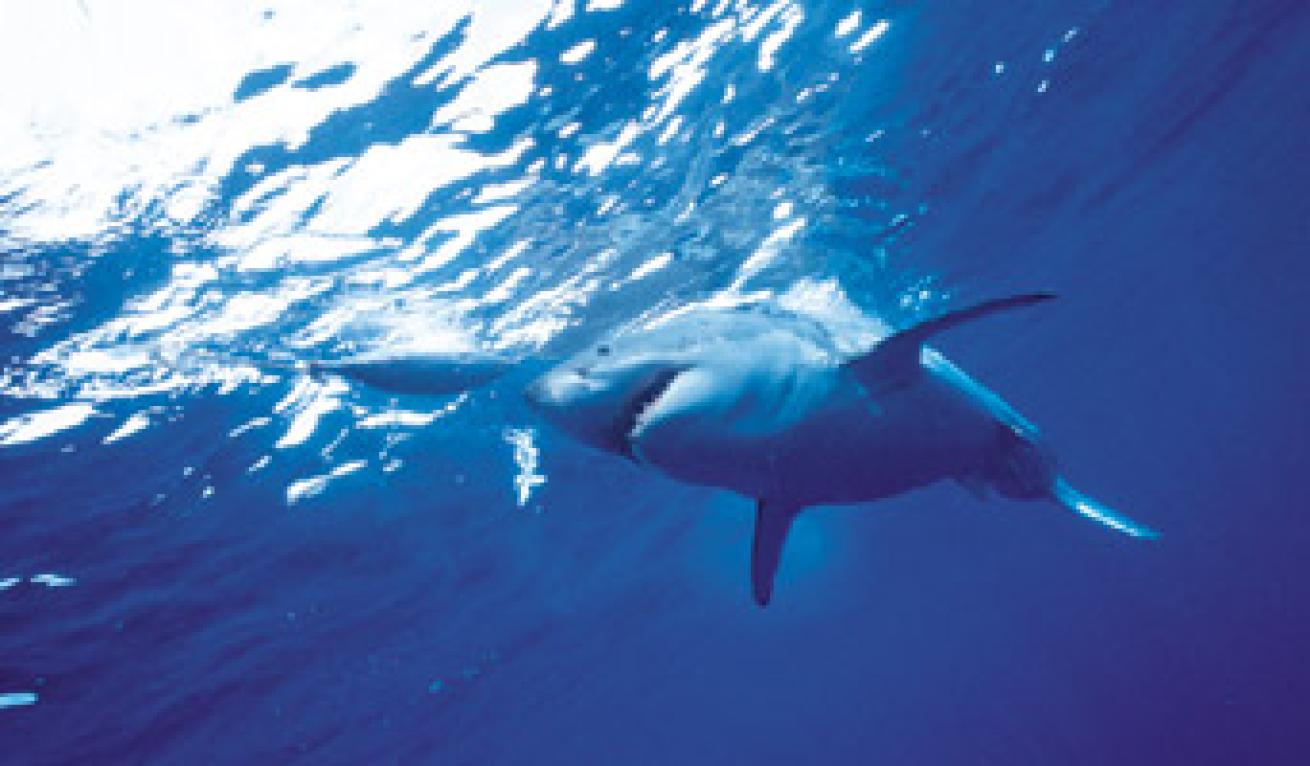Guadalupe

An excellent sense of smell helps this great white hone in on a fishy snack.
March 2003
By Brandon D. Cole
Behold the fierce great white! Since sunrise, we've been laying down an odiferous puree of mackerel, tuna oil and blood in the lee of Mexico's Isla Guadalupe and we have our first visitor. At 12 feet, she's a magnificent specimen, but her approach to predation seems rather half-hearted. No fury, no gnashing teeth, no predatory blitzkrieg. She sniffs lazily around the chum slick. Confident, yet cautious, she makes a pass by our shark cage, then investigates the whole tuna carcass we've deployed as a surface bait. She takes a dainty bite, turns and--in water with a good 80 feet of visibility--vanishes.
Poof! Gone. Just like that. Instant stealth mode courtesy of "countershading" camouflage, dark on top and light below, that lets great whites sneak up on prey. Suddenly, the cage doesn't seem so safe, especially when big mama suddenly and silently rematerializes at an oblique angle in what would be perfect attack formation. The lesson: Apex predation isn't all about power and violence. It takes craft and cunning, too.
Location, Location, Location
Located 150 miles off Mexico's Baja Peninsula, Isla Guadalupe is the hot new place for great white encounters. The lonely barren rock in the Eastern Pacific may lack topside appeal, but it's home, sweet home for the primordial beast we've come to see--Carcharodon carcharias.
The island's deep-water location and other natural features draw migrating white sharks to the island every fall. It's just 22 hours away by live-aboard from San Diego, and with trips priced at just over $2,000 for a five-day, all-inclusive live-aboard cruise, it's a bargain when compared to cage diving expeditions in Australia and South Africa that can easily cost $5,000 or more.
The usual white shark rules apply. The crew deploys the cages and begins chumming the water while guests get a safety briefing and wait for the first diners to arrive. When the cry rings out--"Sharks!"--divers clamber into gear while crewmembers man the bait lines in an attempt to keep the sharks from devouring the whole tuna carcass hors d'oeuvres in one bite.
Each "shift" of divers typically gets about an hour in the cage, breathing off surface-supplied hookah rigs. I've just settled in on my first shift in the cage, happily shooting the coy female when things start to heat up. A feisty, 10-foot male shows up apparently trying to win a spot on the Discovery Channel's Shark Week. He powers up from straight below, lunging at baits and darting close to the cages. He seems twitchy, almost nervous, and his presence results in some serious heavy breathing--not to mention some killer shots.

The Horizon crew readies the cage for diving with great white sharks off the coast of Guadalupe.
The Daily Grind
Still pumped on adrenaline, we hunker down for the evening aboard the live-aboard Horizon as Paul "Doc" Anes of San Diego Shark Diving Expeditions brings us up to speed on Guadalupe's sharkiness. A few years ago, sportfishing boats began reporting that white sharks were hanging around the island, some even swooping in to steal prized tuna and yellowtail right off their fishing lines.
That was enough to draw the attention of curious scientists and California dive operators. For the past two seasons, both groups have reliably found great whites prowling the island. Sightings are most common between the months of September and November, when each day of shark diving, indeed, each rotation in the cage, brings new surprises.
On my cruise, one group of divers glimpsed a chance encounter between a large female white shark and a sea lion. Each appeared startled by the other, and both scooted away at warp speed. So much for the bloodthirsty reputation of great whites.
We also enjoyed a brief visit by a shark missing half its dorsal fin. (Video later proved this same individual was spotted here the previous year.) The behavior of the other sharks changed immediately in deference to the battled-scarred veteran. Clearly, there was a pecking order, and he was at the top.
Another highlight of the trip was watching a very clever shark take advantage of the easy tuna meals dangling from the fishing poles of a nearby boat. And then there was the 15-foot monster that showed up just after the last shift of divers climbed on deck. He was intent on savaging the remaining baits, and try as our wranglers might to save them, the shark won the tug-of-war.
With the last of the tuna gone, the shark dipped back beneath the surface and an awed hush fell across the deck of the boat. Flashing a devilish grin, Doc broke the silence. "I think we're onto something really special here."

Still hungry? This great white decides to go in for another bite.
Why Guadalupe?
by Lance Leonhardt
The scientific jury is still out on why Isla Guadalupe is white shark central, but research indicates that it might serve as a convenient fast food stop on seasonal trans-Pacific migrations.
From August to December, the island is home to an estimated population of 20 to 50 sharks, most nearing adulthood and averaging 10 to 14 feet in length. The occurrence of great whites during this time coincides with the presence of elephant seals, sea lions and fur seals along the island's narrow, rocky beaches. All three pinniped species are on the white shark's menu, especially the plump and naive juvenile elephant seals. With a body composition of nearly 50 percent fat, a young elephant seal contains enough energy to allow a white shark to go a month and a half between meals.
The sharks at Guadalupe probably begin their lives along the Southern California coast between Point Conception and the Mexican border. As they mature into adults, the sharks shift their predatory habits. Instead of hunting fish, they begin to go after marine mammals, migrating seasonally to locations with healthy seal populations.
What white sharks do once they leave Guadalupe is being charted through the use of satellite tags by the Pfleger Institute in Oceanside, Calif. Data from more than 20 tagged sharks over the last three years shows that during winter and spring, the sharks move into the deep waters of the eastern and central Pacific, says researcher Michael Domeier. Similar migratory movements have been recorded for white sharks tagged by scientists at the Farallon Islands, off northern California, and it's possible that the two populations mix when moving offshore.
The One-Day Great White Dive
by Lance Leonhardt
If you want to spend less time and money for a chance to see some of the world's largest white sharks, one-day trips to Southeast Farallon Island in the Gulf of Farallones National Marine Sanctuary offer an exciting alternative.
Trips run from mid-September to mid-November. A one-hour boat ride transports a maximum of six divers from Alameda, Calif., across San Francisco Bay to the hunting ground of white sharks ranging in size from 16 to 20 feet.
The boat typically anchors in about 60 feet of water, a few hundred yards off beaches lined with juvenile elephant seals, a favored prey of white sharks. At these nearshore locations, the sharks patrol deep enough not to be seen, but shallow enough to ambush unwary seals from below.
Chumming with animal blood is prohibited here, so to bring inquisitive white sharks close to the cages, Capt. Lawrence Groth and his crew reel elephant seal decoys through the area. The results are often spectacular. As many as seven white sharks have been seen by divers in the cage, while the divers waiting on deck have witnessed leaping breach attacks.
Divers can expect anywhere from 20- to 60-foot vis, with water temperatures typically in the high 50Fs. Each trip spends about nine hours on site and divers go into the cage in two-person shifts for 30 minutes at a time.
For more information, contact Golden Gate Expeditions, (510) 814-8256, web: www.greatwhiteadventures.com/expeditions.htm. Absolute Adventures, (415) 664-7344, web: www.sharkdiver.com, also offers nondiving trips to the Farallon Islands.
Dive In: Guadalupe White Sharks
LOCATION: In Mexican waters, 210 miles southwest of San Diego, Calif.
WATER CONDITIONS: Expect water temperatures ranging from 65F to 70F. A full 7mm wetsuit is recommended. Visibility averages 60 to 100 feet.
PROFILE: Cage diving utilizes surface-supplied hookah rigs. All you need to take is your exposure suit, booties, hood, gloves and mask. Leave your BC, fins and regulator behind. The dive boat provides weights, belts and air.
SEASON: August to December.










